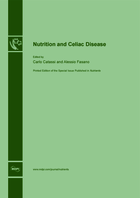Nutrition and Celiac Disease
A special issue of Nutrients (ISSN 2072-6643).
Deadline for manuscript submissions: closed (31 August 2013) | Viewed by 316326
Special Issue Editors
2. Italian Society for Pediatric Gastroenterology, Hepatology and Nutrition (SIGENP), Milan, Italy
Interests: celiac disease; gluten-related disorders; gluten sensitivity; pediatric gastroenterology; pediatric nutrition
Special Issues, Collections and Topics in MDPI journals
Special Issues, Collections and Topics in MDPI journals
Special Issue Information
Dear Colleagues,
Celiac disease (CD) is an autoimmune disorder occurring in genetically predisposed individuals, and triggered by the ingestion of dietary gluten, the major protein component in wheat, barley and rye. In many areas of the world, CD is one of the commonest lifelong disorders affecting approximately 1% of the general population. Treatment of CD is based on the lifelong exclusion of gluten-containing cereals from the diet. The changes needed to begin and maintain a gluten-free diet (GFD) are substantial and have a major impact on daily life. Over the past 30 years the developments in the nutritional aspects of celiac disease have been huge. Nutrient deficiencies have been described in celiac patients both before and after diagnosis, due to intestinal malabsorption and specific limitations of the GFD, respectively. The relationship between the level of gluten intake and intestinal damage has been analyzed leading to new Codex Alimentarius recommendations on the gluten threshold in gluten-free food. Contamination with gluten of the GFD is an important issue in CD management. The spectrum of cereal toxicity for CD patients has been investigated with practical implications on the GFD. The nutritional quality of gluten-free food is constantly improving thanks to the new scientific approach in the technology of gluten-free wheat substitutes. The purpose of this special issue is to provide a summary of contemporary issues and invite contributions that describe new insights into the dietary management of CD.
Professor Carlo Catassi
Professor Alessio Fasano
Guest Editors
Submission
Manuscripts should be submitted online at www.mdpi.com by registering and logging in to this website. Once you are registered, click here to go to the submission form. Manuscripts can be submitted until the deadline. Papers will be published continuously (as soon as accepted) and will be listed together on the special issue website. Research articles, review articles as well as communications are invited. For planned papers, a title and short abstract (about 100 words) can be sent to the Editorial Office for announcement on this website.
Submitted manuscripts should not have been published previously, nor be under consideration for publication elsewhere (except conference proceedings papers). All manuscripts are refereed through a peer-review process. A guide for authors and other relevant information for submission of manuscripts is available on the Instructions for Authors page. Nutrients is an international peer-reviewed Open Access semimonthly journal published by MDPI.
Please visit the Instructions for Authors page before submitting a manuscript. The Article Processing Charges (APC) for publication in this open access journal is 500 CHF (Swiss Francs) for well prepared manuscripts submitted before 30 June 2012. The APC for manuscripts submitted from 1 July 2012 onwards are 1000 CHF per accepted paper. In addition, a fee of 250 CHF may apply if English editing or extensive revisions must be undertaken by the Editorial Office.
Keywords
- celiac disease
- gluten sensitivity
- wheat allergy
- gluten
- nutrient intake
- fiber
- malnutrition
- gluten-free diet
- gluten-free food
- gluten contamination
- gluten threshold
- oats
- dietary treatment
- compliance








